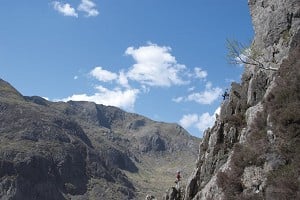
You've completed a top-roping course and the climbing bug has bitten. You start to fantasise about the big wide world outside the climbing wall, particularly its lumps of rock: the arching overhangs, the bulging buttresses and the angular arêtes. In your mind's eye you're up there already, one of the helmeted dots dangling from a monstrous cliff above some river, sea or valley.
How to get up there for real?
My advice is to get on a leading course.
But perhaps you want a taste first - time to acquaint yourself with the nuances of rock climbing where the holds aren't coloured red, pink or blue/black spots (a clue: you have to find them for yourself).
In this case, providing you're confident with your belaying skills, seconding is a good way to learn. Here are some indispensable tips:
(And remember you won't win cool points for rushing off to buy a new and shiny rack only to find that hanging on one arm while trying to jam some gear into an invisible crack above a 20m drop isn't actually your idea of fun. It only shows you have an excessive disposable income.)
- First - find a willing lead climber: a solitary and obliging one. Perhaps you should ask yourself why it is they are solitary, but in your situation you can't be that fussy.
- Second - approach them with respect and make sure they know you are impressed by their superior knowledge in all things climbing. If you can bear it, spend time with them in the pub listening to their fascinating tales of fun and frolics on the crag – gasp at those near death experiences and marvel at the challenges overcome.
Note: It's important to explain how you're an innocent but also to ensure you generate an aura of safety. Don't tell them about those little slips you may have made when belaying...and don't mention the word 'fall' at all. And if they mention this same word more than a couple of times then seriously question whether you want to put your life in this person's hands – it does work both ways (or if you're really fixed on this course then just make sure you've drawn up a will).
- Third - once some sort of rapport is established, fix a date.
Things to bring with you (listed by importance):
- Sandwiches are a good idea. There's a lot of faffing around on the crag and there's many a time that it's suddenly lunchtime before you've even put your harness on, and there's rarely an easily available Greggs to hand (if there is, please let me know).
- A couple of slings: everyone has them over their shoulders and very stylish it looks too. And it makes you appear as if you know what you're doing. I especially like the red and white stripy ones; they seem to go with all my climbing outfits. Take several - of different lengths and colours if you want to look good.
- Rock shoes, harness and belay device all go without saying... actually 2 devices are essential. When you've just had a climb that leaves your arms so pumped you can't trust your fingers to do as they're told, there's always the possibility that during a desperate fumble with a karabiner it could fly away and end up half way down the crag. Take a spare to avoid embarrassment and being blacklisted for future vertical play.
- A helmet is usually recommended. If it's not, do another quick risk assessment of your partner.
- A funny short piece of rope called a prusik - invaluable if you haven't abseiled much and don't want to scream like a girl on the first few descents.
- Find yourself a nut key (not sure why it's called that). If your lead is someone who puts their entire body weight onto every piece of gear they place, that's great for them but less so for you - you're the one who has to extricate it, and this is when you'll find your nut key comes into it's own. Removing gear that appears welded to the rock forming some new form of conglomerate may be done easily with a hammer and chisel but they have their disadvantages –they're a bit of a heavy burden and two hands are required (and it's more than likely you'll want one hand free for grasping onto a tiny hold).
- Finally, take a second karabiner. You have to because everyone does; just in case. You'll probably end up using it to attach your walking boots to your harness as you climb, which is no bad thing as precarious descents down gulleys are safer with proper footwear, never mind giving your feet a well deserved rush of blood to the toes.
You will need a LOUD voice:
Don't expect to have to be good at 'Route Finding'. It's a mysterious skill and some never seem to quite get it. Modern guidebooks have lovely photos of the crag with dot- to-dot lines on them and a three-line description that bears no relation to the landscape in front of you. There may be times when your leader has started the route but isn't making any progress, and after what seems like an hour they finally announce they're lost. Then you'll have to shout out directions very loudly. If all else fails, you'll be carrying the book up with you (another use for the Karabiner).
And talking of routes, be aware that the grades on indoor routes have no equivalent on real rock. You may sail up a 6A at the climbing wall but you'll come badly unstuck on an E1 5b. Find out about the grading system so you can have a say in the day's ambitions. Read the description, take a look at it and both know and vocalise your limits – or you may need to take a pair of clean pants.
While you'd have thought 'calls' were something everybody bothered with, apparently you can't presume this. It's right to expect to hear the words 'safe' at some point before the rope is dragged out of your hands, and it's sensible to shout 'off belay' in response. The whole thing can get a bit stressy if you don't. And hearing is as important as a loud voice - if you can't hear the words ' climb when ready' you could be in for a long day (and of course don't forget to let them know when you've started your ascent unless you like a lot of loose rope to trip up on/fall on).
As your education progresses and you encounter different lead climbers, be prepared for different routines. Demands and expectation vary greatly from leader to leader: Some will almost do everything for you (not a great way to learn), while others will expect some precise participation and get pissy if you don't follow orders with cheerful enthusiasm. Some expect a knowledge of rope management - how to flake it and make it look neat and pretty at the end of the climb (and it looks very competent if you can do that clever thing of curling it up over your shoulders).
If you've never belayed on half ropes (that's those 2 thin ropes that aren't halves at all) then find out how to before having to confess your ignorance - which doesn't inspire confidence in someone with their life in your hands. Handing over precious and beloved gear at the end of the climb or pitch is an important ritual - and again you'll find each leader has his or her own method (in that way of rituals). Just grin and bear it.
I'd say the best thing, as an amateur, is to do as you're told. But if in doubt and you don't want to stand around looking helpless for too long do this:
- Flake the rope (s) - the right way up (your end at the bottom), and in the right place: preferably somewhere near the route.
- Tie in (properly) or later risk the end of the rope disappearing up the crag without you.
- Put your climber on belay and say clearly (loud voice remember), 'climb when ready'.
So up you go and clean the route behind them – after all, it is your main function. And as such it's imperative you remove every bit of shiny expensive gear – or, simply put, you won't be climbing with them again. A nut key, strong arms and the patience of a saint are all that's required. If you get a chance, have a play around with those appealing pieces of gear comfortingly called 'friends' or 'cams' before embarking on this adventure. They're very clever pieces of machinery but they have a habit of disappearing deeper and deeper inside a crack if you aren't familiar with their mechanics (and they aren't cheap, so you'll definitely be on the black climbing-partner list if any have to be abandoned). Try not to be too vigorous with seemingly immovable gear as the shock of a sharp pull that goes nowhere can be very unbalancing.
Advice concerning the behaviour of leads:
Some leaders have a cruel streak and feel it's character building to keep the rope slack as you climb. Remember you're there to both enjoy yourself as well as learn. Too much fear isn't fun and can put you off in the future. You're allowed to demand a tight rope (look out for those who respond by letting out more slack. It's not big and it's not funny, but try not to take revenge out on them on the crag: that would be dangerous).
Last but not least, if you've had a good day and done nothing to embarrass yourself, you'll deserve a drink in the local – but remember that you'll be buying, and will have to listen once again to those tall tales of high places...
Of course it may be easier just to go on a course...
- The Aspirant Mountaineer - Grooved Arete - Tryfan 25 Oct, 2013
- 'All Rounder' Rock Shoes 29 Jun, 2011
- Zamberlan GT RR Torre Women's Boots 23 Feb, 2011
- Ice Maidens 15 Feb, 2011
- Mountain Equipment Women's Combin Trousers 2 Jan, 2011
- COMPARISON REVIEW: Women's Soft Shell Jackets 27 Oct, 2010
- La Sportiva Cliff 5 Rock Shoes 1 Oct, 2010
- What's In A Partner? 15 Mar, 2010
- How do YOU like it? Fast or slow? 21 Oct, 2009
- Belay Bunnies and Gear Tarts 9 Jun, 2009

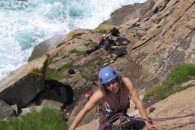

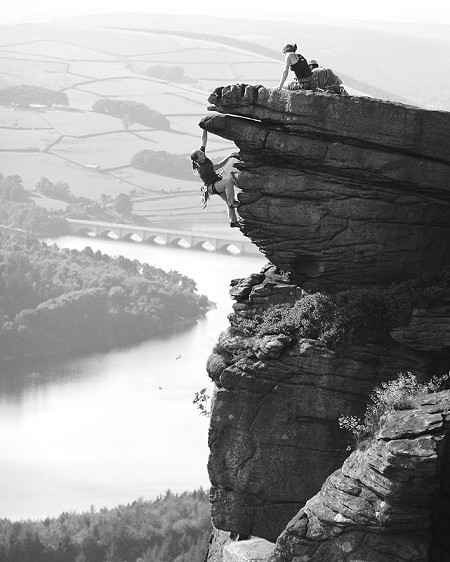

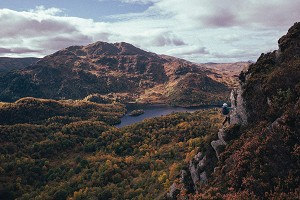
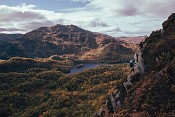
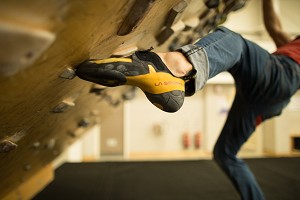









Comments